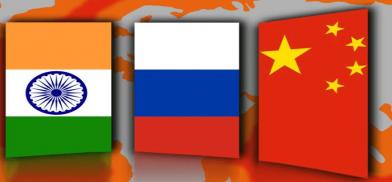Should India continue to engage with the RIC?
For India, however, questions arise whether the RIC fits New Delhi’s objectives as it increases its strategic engagement with the United States, Japan, and Australia which goes against the RIC’s objective to undermine a growing American presence in the Indo-Pacific, writes Shantanu Roy-Chaudhury for South Asia Monitor

In 1998, Russian Prime Minister Yevgeny Primakov drafted the concept of a Russia-India-China (RIC) strategic triangle as a doctrine of multipolarity to serve as an alternative to the United States-imposed unipolarity after the Cold War. Although not an anti-West concept, the strategic triangle was meant to serve as a counterbalance to the Western alliance, and Primakov argued the troika would allow protection for nations not allied to the West.
The developments that led to Russia seeking a closer strategic relationship with India and China are threefold. First, the inability to prevent the North Atlantic Treaty Organization (NATO) from expanding closer to Russia’s borders and the unilateral action that was taken in Kosovo; second, Russia, India, and China’s problems with Islamic militants in Kashmir, Chechnya and Central Asia, and Xinjiang, respectively, and common ground on fighting militancy; and third, there was a common interest in the arms trade.
Does RIC fit Indian objectives?
During a period when India and China accounted for almost 70 percent of Russia’s arms exports, and Indian apprehensions on Russia exporting systems with the same features to China, the RIC would be a platform to appease Indian sensitivities. Although the RIC has not developed into a strategic triangle to the extent as envisaged by Moscow, the three countries, all of which are nuclear powers, and together occupy over 19 percent of the global landmass and contribute more than 33 percent of the world’s GDP, has been meeting annually as a part of the RIC grouping.
The latest RIC meeting took place on June 23, 2020, represented by the foreign ministers of the three countries. Amidst a border clash and standoff between Indian and Chinese troops along the Line of Actual Control (LAC), India’s External Affairs Minister S Jaishankar confirmed his virtual attendance with Moscow stating bilateral issues were usually not on the table for discussion.
For India, however, questions arise whether the RIC fits New Delhi’s objectives as it increases its strategic engagement with the United States, Japan, and Australia which goes against the RIC’s objective to undermine a growing American presence in the Indo-Pacific. While China sees the US Indo-Pacific policy as one to contain China, Russia views it as an American strategy to draw India and Japan into a military alliance. The US, on their part, have not alleviated Moscow’s concerns and it is in New Delhi’s interests to draw the Russians into the Indo-Pacific through the Chennai-Vladivostok maritime corridor.
Furthermore, with China’s increasingly assertive foreign policy towards India and in South Asia, and increasing calls for a re-thinking of India’s China policy, it becomes increasingly difficult to see constructive engagement between India and China in limited international forums like the RIC, Brazil-Russia-India-China-South Africa (BRICS), and the Shanghai Cooperation Organization (SCO).
Additionally, with Russia also growing wary of an increasing Chinese footprint in Central Asia, combined with not recognizing Chinese claims in the South China Sea, and vice versa on Crimea as a part of Russia, the two countries do not see eye to eye in what is often termed a “friendship of convenience.” there is no doubt tensions are growing within the RIC.
India can shape Russia-China dynamics
These developments, however, should not mean India should abandon engaging Russia and China through the RIC. New Delhi should, in fact, increase its participation and demand India’s concerns to be taken more into account. Presently, the RIC joint statements are more geared towards Russian and Chinese interests with India acting as an additional signatory. Furthermore, Russia often views India as a means to balance China, and India should make the most of this by addressing New Delhi’s China concerns which include those of arms exports to Beijing. With India and China buying similar weapons systems from Russia, India should use its relationship with Moscow to check exports to China which have been known to reverse engineer products for indigenous production.
During the border clash along the LAC, Chinese media also urged Russia not to sell arms to India. More importantly, India needs to continuously engage the two countries with respect to Central Asia. The region, which is strategically located is just north of Pakistan Occupied Kashmir is crucial for trade routes and the natural resources present in the Central Asian Republics.
It is, therefore, important for India to shape the Russia-China dynamics and prevent them from establishing a duopoly in the region. The International North-South Transport Corridor (INSTC) that will link India to Central Asia through Iran and Afghanistan is an important aspect of maintaining a presence alongside Russia and China. For India, the RIC acts as another platform to preserve good relations with Russia and to express concerns and foreign policy visions. It should, therefore, also be used to find points of convergence with Beijing.
While the RIC grouping has many delicate and complex parts to it, with bilateral tensions between India and China, and between Russia and China, Moscow needs Beijing and New Delhi, especially in the post-COVID world.
Similarly, New Delhi views Moscow as an invaluable strategic partner and China knows Russia’s approval is imperative for the success of its Belt and Road Initiative across Eurasia.
(The writer is Research Associate, Centre for Air Power Studies (CAPS), New Delhi. The views expressed are personal. He can be contacted at shantanuroychaudhury@gmail.com)










Post a Comment